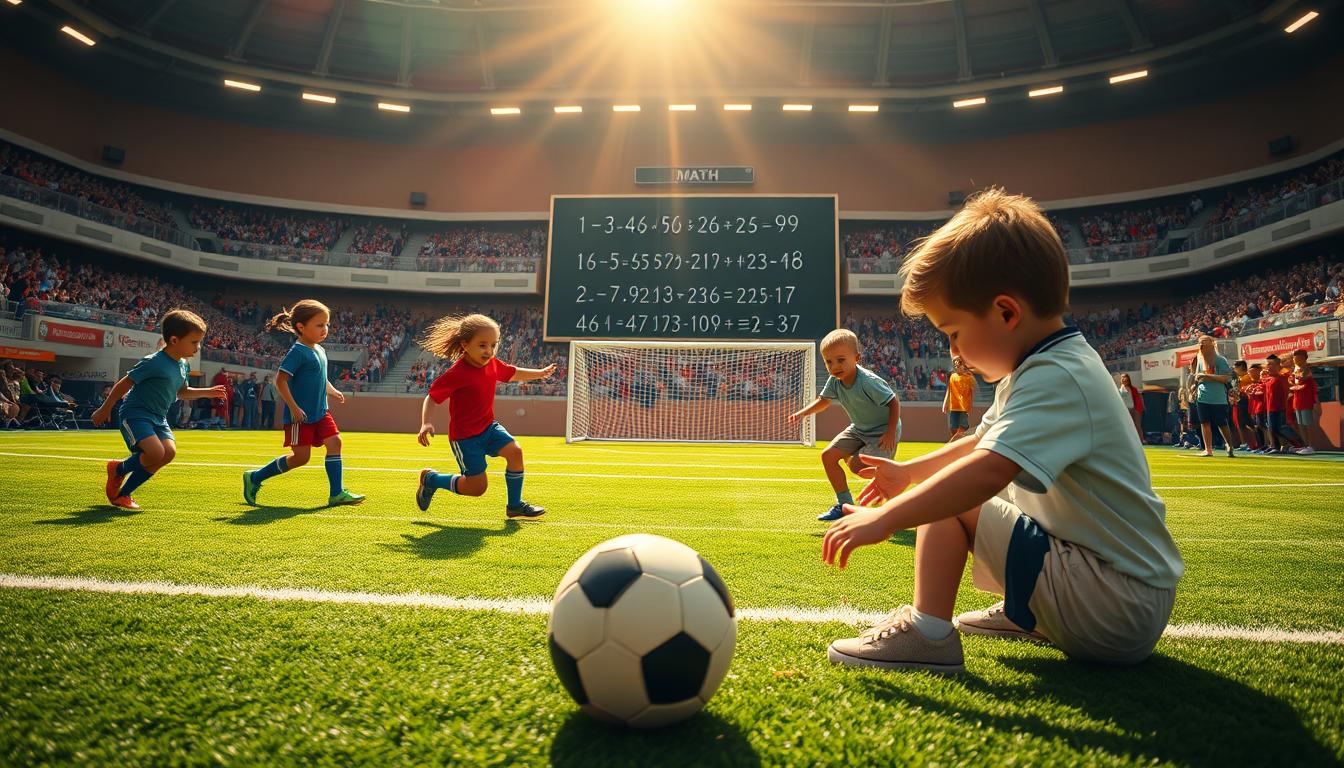Soccer Counting Games for Kids: Top 10 Fun Activities

What if your child could boost math skills while scoring goals? Combining physical activity with number practice isn’t just possible—it’s a blast. Soccer-themed counting activities turn dribbling and shooting into exciting learning moments, helping young players master addition, subtraction, and even fractions without staring at a textbook.
This article shares 10 creative exercises that blend sport and education. Whether your student works alone or with teammates, these drills use real-game scenarios to reinforce math concepts. You’ll find step-by-step instructions for each activity, all designed for elementary-aged learners. Best part? Most require minimal setup—just a ball, cones, and enthusiasm.
Key Takeaways
- Transform soccer drills into math practice with interactive challenges
- Improve skills like addition, subtraction, and fractions through play
- Adapt activities for solo practice or group sessions
- Use common sports equipment for quick, low-prep learning
- Align games with elementary math curriculum standards
- Encourage teamwork while solving number-based problems
Discover the Excitement of Soccer and Math
Kicking a ball and solving equations might seem worlds apart, but they’re not. When you merge athletic movement with number challenges, learning becomes an adventure. Children naturally engage with concepts like addition and numeral recognition when they’re physically involved in the process.
Learn Through Active Play and Counting
Try this: Place numbered cones (0-20) around a practice area. Have players dribble the ball to specific targets while shouting out each digit. For younger learners, match foam balls marked with dots to corresponding goalpost numbers. Movement solidifies memory—kids retain 20% more math facts when paired with physical activity.
Simple Steps to Begin Your Soccer Math Journey
Start with three easy setups:
- Print number cards and tape them to mini goals
- Use a timer to track how quickly players solve problems between kicks
- Create a scoring system where correct answers equal extra points
These drills require just a ball, markers, and open space. Best yet? You can adapt them for backyard practice or team sessions. Confidence grows as players see their math skills and footwork improve together.
Soccer counting games for kids: Learning Through Play
Ever wondered how a soccer field can double as a math classroom? These activities use straightforward rules to turn passes and goals into number challenges. Clear instructions let players focus on skill-building rather than complicated setups.

Understanding Game Mechanics and Easy Rules
Start by marking zones with numbers 1-10. Players kick the ball to land in specific areas, then shout the total as they combine multiple hits. For example, hitting zone 3 and zone 5 requires calling out “8!” before taking another shot.
Three core principles keep it simple:
- Instant feedback: Correct answers earn extra dribble time
- Flexible formats: Play solo against a timer or team up for collaborative scoring
- Progressive difficulty: Switch from single digits to equations like 12-4 after mastery
Digital versions work without apps—try projecting a virtual field on a wall. Players solve problems shouted by teammates to “unlock” shooting angles. Structured turns ensure everyone practices both arithmetic and coordination.
Best part? You only need a ball and numbered targets. Rotate between solo drills and group matches to maintain excitement while reinforcing core concepts through repetition.
Interactive Activities and Practice Sessions
Ready to turn drills into thrilling math adventures? These dynamic exercises blend strategic thinking with physical action, creating memorable learning moments. Players strengthen arithmetic skills while developing footwork precision through three core formats.
Addition and Subtraction Soccer Challenges
Mark five targets with numbers 1-20 across the field. Players solve equations like 7+5 or 14-3 shouted by a coach, then kick the ball to the correct answer zone. Earn bonus points for hitting moving targets pulled by teammates.
| Challenge Level | Math Skill | Soccer Action |
|---|---|---|
| Beginner | Single-digit sums | Stationary kicks |
| Intermediate | Two-digit equations | Dribble-and-shoot |
| Advanced | Three-number operations | Header passes |
Decimal, Fraction, and Mixed Number Games
Upgrade the challenge with advanced concepts. Shoot at goals labeled 0.25, ½, and ¾ while converting fractions to decimals. For team play, split into groups that round numbers to nearest tenths before passing.
Solo and Team-Based Soccer Math Exercises
Individual drills build precision: simplify 4/8 to ½ before taking three penalty kicks. Group activities foster collaboration—teams race to solve 15-7+2 while passing through obstacle courses.
Digital versions work seamlessly on tablets. Correct answers unlock virtual goalkeeper movements. Immediate feedback comes through celebratory animations for right solutions and encouraging retries for misses.
Final Kick: Bringing Soccer Math to Your Routine
Imagine transforming every practice into a math adventure that sticks. These soccer math games blend movement with number skills, making daily drills feel like championship matches. Students build fluency through activities matching numeral cards to ball quantities or solving equations between passes.
Structured order in exercises helps learners grasp sums and differences naturally. Start with basic addition before progressing to subtraction challenges. Rotate between solo drills and team battles to keep energy high while reinforcing concepts.
Digital tools offer instant feedback through quick-fire problems, while printed materials let you replay favorite games anywhere. Clear instructions mean no confusing setups—just grab a ball and numbered targets. Regular play strengthens both footwork and arithmetic without screen time.
Ready to score big in math? Commit to 15-minute sessions three times weekly. Track progress by timing how fast equations get solved during dribble races. Consistency turns practice into mastery, one kick at a time.
Grab a ball, print those cards, and watch math skills soar with every kick!
